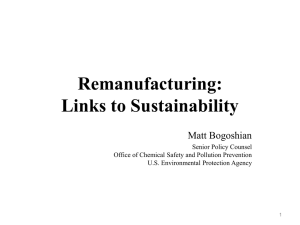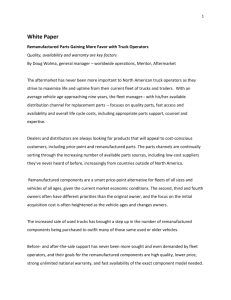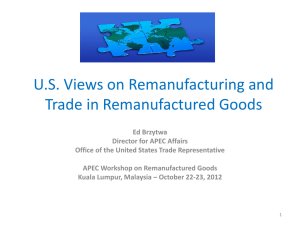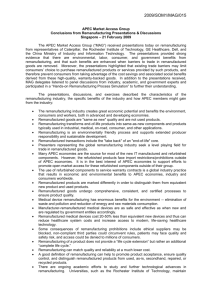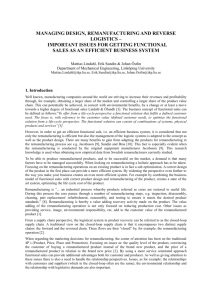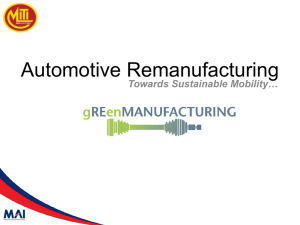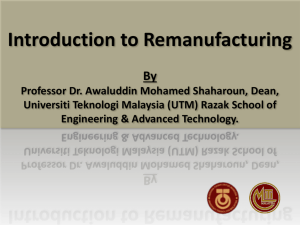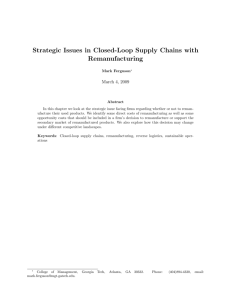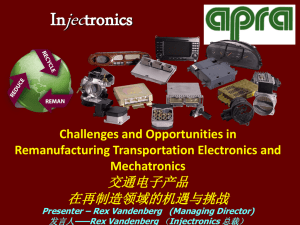REMANUFACTURING IN AFRICA
advertisement
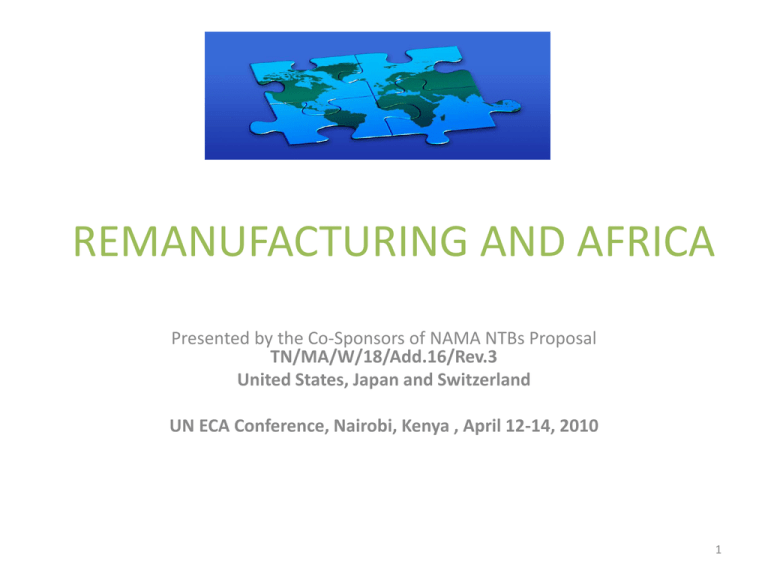
REMANUFACTURING AND AFRICA Presented by the Co-Sponsors of NAMA NTBs Proposal TN/MA/W/18/Add.16/Rev.3 United States, Japan and Switzerland UN ECA Conference, Nairobi, Kenya , April 12-14, 2010 1 What is Remanufacturing? • Remanufacturing is an industrial process that uses “cores” or end of life components and restores to them new condition. • A remanufactured good is “a non-agricultural good that (1) is entirely or partially comprised of parts (i) that have been obtained from the disassembly of used goods; and (ii) that have been processed, cleaned, inspected, or tested to the extent necessary to ensure they are in original working condition; and (2) has a warranty.” • Remanufactured goods should meet the same technical and/or safety specifications (standards and/or technical regulations) that apply to an equivalent new good. 2 How does the remanufacturing process work? 3 What kinds of technology is used? Industry Examples 4 What kinds of goods are remanufactured? • Companies are using remanufacturing across an expanding range of products. • Examples include: earthmoving equipment, automotive parts, medical devices, information and communication technology products, industrial machinery, precision instruments, and office equipment, including toner and ink cartridges. 5 How do remanufactured goods differ from used goods? • A remanufactured good, unlike a used good, should meet the same technical and/or safety specifications (standards and/or technical regulations) that apply to an equivalent new good (i.e., the remanufactured good when it was originally manufactured) • A remanufactured good should have a warranty. Used goods often do not have warranties. • Some countries use a labelling regime so that customers at the point of sale or customs at the point of entry can identify that a good is remanufactured. 6 How large is international trade in remanufactured goods? • No separate tariff lines exist for remanufactured goods, but landmark 1998 study estimated the global market for remanufactured goods to be $100 billion. In following 12 years, much expansion and growth. • Global Industry Analysts recently estimated the global market for remanufactured auto parts alone to be $104.8 billion annually by 2015. • Through international investments we can see that remanufacturing of industrial machinery, earthmoving equipment, electronics is growing, especially in developing countries. • Global market for remanufactured ink jet and toner cartridges estimated to be more than $5 billion annually. More than 10,000 remanufacturers worldwide, employing more than 65,000 people. 7 Why are environmentalists and Ministries promoting remanufacturing? • Remanufacturing saves manufacturers on average 85% of energy use; 86% of water use; and 85% of the materials used as compared to manufacturing a new good. • Using existing metal components preserves virgin natural resources and avoids carbon emissions caused by smelting metal castings. • Remanufacturing prevents metal and plastic components from ending up in landfills. • For Governments, remanufacturing is a way to clean up municipal waste, save energy in domestic industries, and to create jobs. Source: Remanufacturing, The Ultimate Form of Recycling, Rolf Steinhilper, Fraunhofer IRB Verlag, Stuttgart, 1998, http://www.reman.org/Publications_main.htm, page 98 – 103. 8 What are the labor benefits of remanufacturing? • Source of “Green Jobs” • Labor intensive industry: it takes 40 man hours to create a new engine but it takes 120 to remanufacture one. (Walter Stahel, Performance Economy) • Low automation industry due to hands on disassembly and high skills industry with individual testing of remanufactured units. • Some companies have established training centers to provide remanufacturing skills and knowledge to local workers. • Overall better workplace safety due to lack of furnaces and smelting of components. 9 To What Extent is Africa Involved in the Remanufacturing Industry? Surveying business websites shows that: • Remanufacturing is growing across the region. Some countries have a long tradition of excellence and international trade of remanufactured goods. • There is increasing production of remanufactured printer consumables in many countries. • There is growing intra-African trade in remanufactured goods. • African companies are seeking to market their remanufactured goods worldwide. • There is much more scope for growth of remanufacturing. 10 Examples of African Remanufacturing Facilities Country City/Town Product Type Botswana Francistown Printer consumables Egypt Alexandria Printer consumables Kenya Nairobi Printer consumables Kenya Nairobi Automotive Kenya Nairobi Printer consumables Kenya Nairobi Food Processing Equipment Malawi Blantyre Printer consumables Morocco Rabat Printer consumables Morocco Meknes Printer consumables Tunisia Jemmal Automotive/Engineering Senegal Dakar Training centre 11 Examples of African Remanufacturing Facilities Country City/Town Product Type South Africa Jet Park Automotive/Engineering South Africa Johannesburg Construction Equipment South Africa Port Elizabeth Automotive/Engineering South Africa KwaZulu Fuel Injectors South Africa Springbok Large diesel engines South Africa Silverton Automotive/Engineering South Africa Bramley Automotive/Enginnering South Africa Newcastle and Umhlanga Printer consumables South Africa Pretoria Automotive, Engineering 12 International Trade and Long Tradition of Remanufacturing: Ex. REMTEC, SA • Originally established in 1963 as Volkswagen Remanufacturing by Volkswagen of South Africa, the company was renamed Remtec Manufacturing when it became independent in July 1995. Continued collaboration VW Heritage; a well-established, independent British Volkswagen parts distributor that imports and exports goods worldwide. • The two companies have jointly developed a range of remanufactured air-cooled and light commercial Volkswagen engines for the UK market and it was a natural progression for the companies to look to Europe to increase their range and market. • Remtec is also the exclusive supplier of remanufactured engines to VW of SA, General Motors of SA, Ford Motor Company of SA, Landrover SA and Nissan SA. • Remtec’s Port Elizabeth Plant was the first official large-scale remanufacturer in South Africa and occupies 4,000 square metres. The layout has been specifically designed to optimise 40 years of experience in the remanufacturing business and has been used by other O.E. remanufacturing plants throughout South Africa. Source: http://www.remteceurope.com/router.cfm/action/changeLang/newLang/1/pageID/1/) 13 Other African Industry Examples • • • • Weather Station Solution by Ultimate Retail Solutions (a South African company) helps African farmers predict the weather by tracking rain, wind speed, humidity, etc. The company installs new software onto remanufactured PCs to produce units that are affordable for farmers. EbTech Solutions in Kenya advertises that they offer the highest quality remanufactured toner cartridges at 60% costs savings over new toners. They provide warranties on 100% of their products. They ship anywhere in Eastern Africa. ICC Toner is an Egyptian – US joint venture to remanufacture cartridges in Egypt for export to the United States. Press interview with Georginah Mothusi, a female worker in Botswana’s Eridine Cartridges company: “remanufacturing is a challenging profession when you are a beginner but is one of the most fulfilling careers.” She remanufacturers and inspects 30 cartridges a day as part of her job. 14 Other African Industry Examples Personal Computers • Community Microsoft Authorized Refurbishers (MAR) – 45 total in Africa: Burkina Faso (1), Kenya (2), Cameroon (1), Gabon (1) Liberia (1), Mauritius (1), Nigeria (11), Morocco (1), South Africa (20), Swaziland (1), Tanzania (3), Tunisia (1), and Uganda (2) • Example: UNIDO and Microsoft Unlimited Potential helped start Uganda Green Computers Co. in Kampala in 2008 • Organization such as Digital Links and Close the Gap supply refurbished PCs to users in many countries in Africa and have helped establish refurbishment companies and centers 15 Why NAMA NTBs? What is the Problem? • • • • • A range of restrictive policies are still applied to trade in remanufactured goods, such as: Non-automatic import licensing procedures Import prohibitions Excessive documentation requirements Discriminatory product inspections Product bans importation of used goods Fundamental concern: regulating remanufactured goods as used goods instead of holding them to the quality and performance standards of new goods and treating them as such. 16 What does the NAMA Proposal Envision? Two Elements: Council for Trade in Goods • Twice a year a dedicated discussion in the Council for Trade in Goods where Members raise and discuss specific trade concerns. • This gives the added advantage of members seeing the range of policies that are being applied, learning what policies may be trade restrictive, and learning about best practices. 17 What does the NAMA NTBs Proposal Envision? Second Element: Member-led Workshops on five themes: • Industry: Companies from developed and developing countries describing their operations, processes, and warranty practices and barriers to trade impacting their products. • Environment: Members’ perspectives on the environmental impact of remanufacturing. Examine studies on its benefits. • Regulation: Current practices and alternative approaches to regulation. • Development: Developing countries' experiences in development and adoption of remanufacturing technologies; remanufacturing industry experience in operating in developing countries. • Infrastructure: Infrastructure and institutions need to produce, import, export, assess conformity assessment of remanufactured goods; capacity challenges. 18 Goal of NAMA NTBs Proposal • Meet our mandate to reduce or eliminate non-tariff barriers to trade. • Help to increase and pool WTO Members’ knowledge and experience with the dynamic and expanding global remanufacturing industry. • Better inform regulators and operators about international best practices. 19
